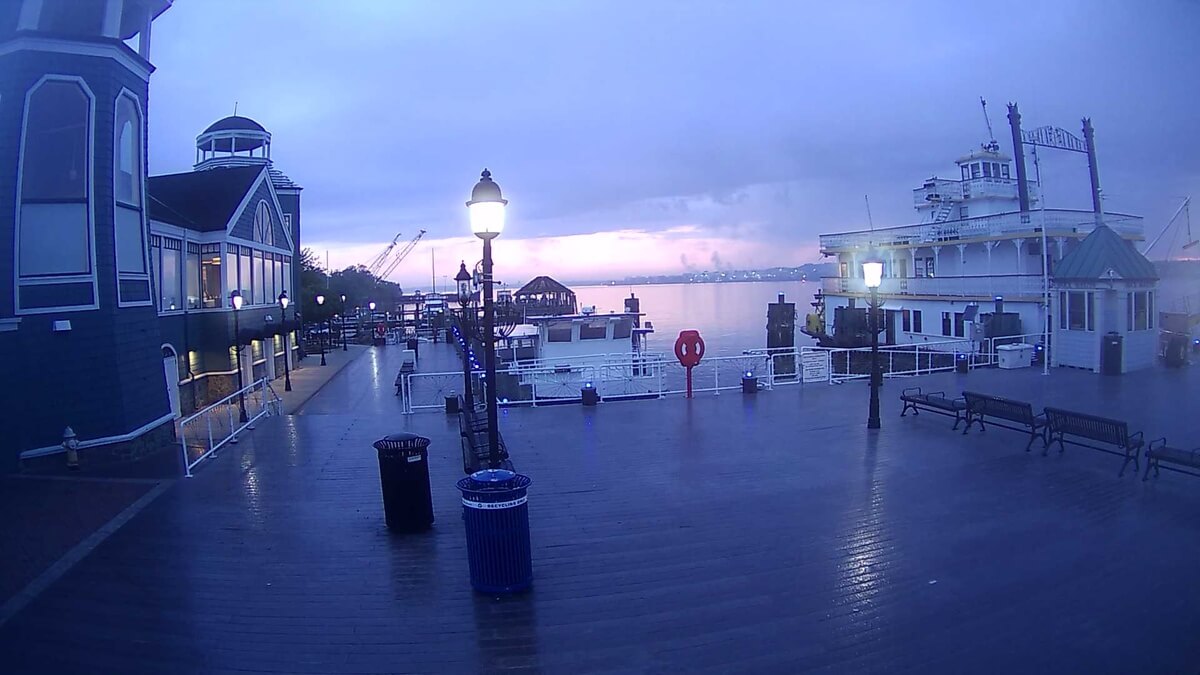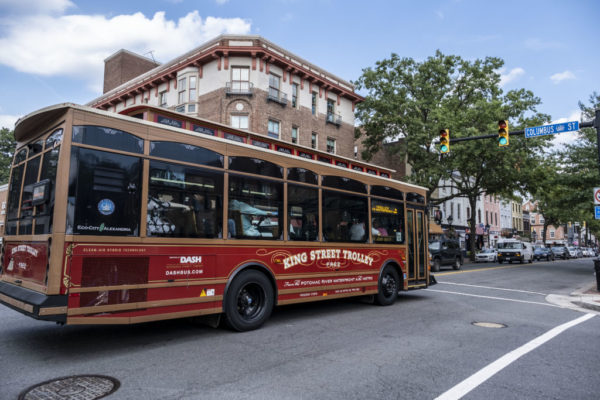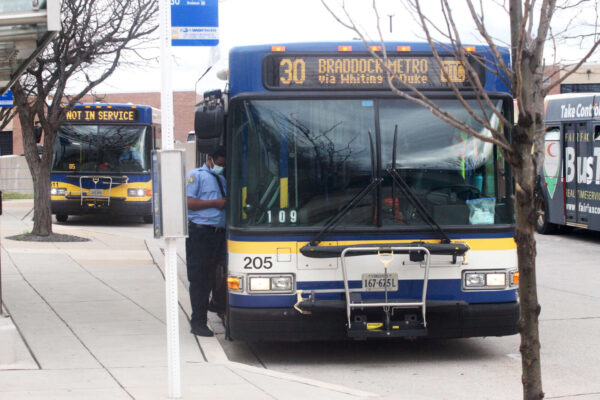A pair of grants totaling $38 million should help boost Alexandria’s electric bus fleet ambitions.
The City of Alexandria and the Alexandria Transit Company (DASH) have been awarded $24 million from the Federal Transit Administration (FTA) in grants to expand its electric bus fleet and continue high-frequency bus service.
“The grant will be used to purchase 13 battery-electric buses and to install charging infrastructure at the City’s bus maintenance and storage facility,” the city said in a release. “The grant will also provide funding to upgrade the DASH facility with additional electrical capacity and to cover the cost of additional training and workforce development programs related to fleet electrification.”
DASH also received a $14 million grant from the Northern Virginia Transportation Commission’s I-395 Commuter Choice Program.
“The funds will be used to maintain high frequency service levels on DASH Lines 35 and 36A/B through Fiscal Year 2025,” the release said. “DASH was also awarded funding to purchase two 60-foot articulated electric buses to increase capacity on Line 35, the busiest route in the entire DASH system.”
Converting Alexandria’s DASH bus system to an electric fleet is a long and often costly process. Earlier this year, DASH General Manager Josh Baker said the city is still buying diesel buses because the funding wasn’t in place to buy electric buses.
“I think we can get to a place where electrification is part of good repair, but at the moment, that cost differential is not funded,” Baker said at the Transportation Commission.
Even $38 million burns pretty quickly with the considerable cost of electric buses. DASH officials said each electric bus costs $1.2 million while diesel buses cost $600,000, not to mention some of the infrastructure cost — though early indications are that electric buses may be less expensive to operate and maintain than diesel buses.
Still, Baker said the grant funding will help boost Alexandria along the path to getting more electric buses on the streets. The city’s goal is to have the entire DASH fixed-route fleet all-electric by 2037, which will require all new bus purchases starting in 2027 to have zero tailpipe emissions.
“The City is committed to reducing its environmental impact and improving air quality,” Baker said in the release. “The purchase of zero-emission buses is a major step forward in achieving these goals. The new buses will help reduce greenhouse gas emissions and improve air quality for all residents of Alexandria.”
Rep. Don Beyer put out a statement applauding the federal investment.
“The bipartisan Infrastructure Investment and Jobs Act is making our air cleaner, our region more connected, and our economy stronger,” Beyer said in a release. “These smart investments will help reduce emissions and create new jobs in Northern Virginia, throughout the region, and across the country. When we put our constituents and communities first, we can grow the middle class and rebuild America’s crumbling infrastructure. This is the way.”
Photo via DASHbus/Facebook
Good Monday morning, Alexandria!
☔ Today’s weather: Passing showers. Overcast. Mild. High of 66 and low of 53.
☔ Tomorrow: Rain. Cloudy. Mild. High of 71 and low of 57. Sunrise at 6:01 am and sunset at 8:07 pm.
🚨 You need to know
After eight months, the Washington Metropolitan Area Transit Authority reopened it’s yellow line on Sunday. The line has been out of service since September to allow work on the Potomac River tunnel and bridge.
“The work included replacing over 1,000 individual steel plates held together by more than 12,000 bolts in the tunnel and replacing 88 bearings on the bridge,” according to WMATA. “The project also upgraded the fire suppression system on the 3,000-foot bridge and removed and replaced miles of critical communications cables used by multiple regional partners.”
📈 Friday’s most read
The following are the most-read ALXnow articles for May 5, 2023.
- Giant Food on Duke Street adapts to shoplifting increase by locking one of its front doors (858 views)
- Notes: APD ‘determined’ to reduce crime near Braddock Road Metro after more shots fired (829 views)
- ALXnow’s top stories this week in Alexandria (798 views)
- Just Listed in Alexandria | ALXnow (129 views)
🗞 Other local coverage
- Yellow Line Roars Back into Alexandria Sunday Morning, May 7, after an Eight-Month Closure
Zebra (Sunday @ 1:21 pm)
- Diapers Needed: Start a Drive in Alexandria To Help HomeAid National Capital Region
Zebra (Saturday @ 12:54 pm)
- New Old Town Location for Alexandria’s Zen Press — Same Hospitality, Delicious, Nutritious Food and Juice Options
Zebra (Saturday @ 9:07 am)
- Theogony Editor Staff at Alexandria City Public High School has Been Announced!
Zebra (Friday @ 7:59 pm)
- Sewer Overflow Affects Stream In Alexandria
Patch (Friday @ 3:49 pm)
- DASH Bus Lines To Serve New Potomac Yard Metro Station
Patch (Friday @ 3:22 pm)
- “Happy to Learn This Was a Drill” Says A Lady in Alexandria about the Dummy Hanging Off Woodrow Wilson Bridge on Monday, May 1
Zebra (Friday @ 1:49 pm)
- Lily’s Chocolate and Coffee to Open Soon
Alexandria Living (Friday @ 11:42 am)
- Free Concerts Start June 4 at Fort Hunt Park
Alexandria Living (Friday @ 10:55 am)
- Melanie Kay-Wyatt Named Permanent Alexandria Schools Superintendent
Patch (Friday @ 10:39 am)
- Charlene’s Kitchen: Alexandrians’ ‘Go To’ for Catering, Events
Alexandria Living (Friday @ 10:20 am)
- Old Town Alexandria Home Dating Back To 1830 Has Patio With Brick Wall
Patch (Friday @ 9:59 am)
- How Blackwall Hitch Is Leading Alexandria Waterfront’s Culinary Resurgence
Alexandria Living (Friday @ 9:45 am)
- Mount Vernon: Revolutionary War Weekend May 6, 7
Alexandria Living (Friday @ 9:29 am)
- Samy Seeks Home with a Friend
Alexandria Living (Friday @ 7:41 am)
- About Alexandria with Mark Eaton: Staggering forward
Alexandria Times (Friday @ 7:41 am)
- Your View: We needed a Metro bond referrendum
Alexandria Times (Friday @ 7:34 am)
- Your View: Decongest Duke Street sensibly
Alexandria Times (Friday @ 7:30 am)
- Our View: Not ‘Poetry in Motion’
Alexandria Times (Friday @ 7:27 am)
📅 Upcoming events
Here is what’s going on today in Alexandria, from our event calendar.
- No events today. Have one to promote? Submit it to the calendar.
Good Friday morning, Alexandria!
🌥 Today’s weather: Cloudy. Mild. High of 69 and low of 51.
🌥 Tomorrow: Cloudy. Mild. High of 72 and low of 52. Sunrise at 6:05 am and sunset at 8:04 pm.
🚨 You need to know
More gunfire was reported near the Braddock Road Metro station yesterday afternoon, prompting the Alexandria Police Department to tweet that it’s “determined” to solve recent crime issues.
“APD has taken action by installing cameras and increasing police presence in the area to ensure everyone’s safety,” APD tweeted. “No one has been hurt, but we’re determined to prevent any potential harm by keeping a police presence there until we resolve this violence.”
Thursday’s incident occurred in the same block as a number of recent shootings. The city is experiencing a crime surge, and police are fighting it by increasing patrols in high-crime areas, installing mobile camera units and hosting community events.
We care about your safety and appreciate the communities cooperation to help resolve this issue.
— Alexandria Police (@AlexandriaVAPD) May 5, 2023
We had such a great time on Monday at Coffee with a Cop that we are planning three more this month! We hope to see you there!
May 9, 2023 – Monarch 800-930 540 N Henry St.
May 16, 2023 – Bradlee 800-930 3690 King St.
May 23, 2023 – Van Dorn 800-0930 5782 Dow Ave. pic.twitter.com/lN1MfBBuwi— Alexandria Police (@AlexandriaVAPD) May 2, 2023
📈 Thursday’s most read
The following are the most-read ALXnow articles for May 4, 2023.
- JUST IN: Police investigating shots fired incident near Braddock Road Metro station (1834 views)
- Fundraiser established for family of the ACHS student who died this week (1203 views)
- Notes: Alexandria driver killed in hit-and-run in D.C. | ALXnow (727 views)
- JUST IN: Melanie Kay-Wyatt announced as Alexandria City Public Schools superintendent (516 views)
🗞 Other local coverage
- Dr. Melanie Kay-Wyatt is the New Permanent Superintendent for Alexandria City Public Schools
Zebra (Thursday @ 10:25 pm)
- Interim Schools Superintendent Becomes Permanent in Alexandria
Alexandria Living (Thursday @ 7:48 pm)
- Dr. Melanie Kay-Wyatt announced as new ACPS Superintendent
Alexandria Times (Thursday @ 7:45 pm)
- Good Food for a Good Cause: ALIVE! Hosting Alexandria Community Cookouts This Month
Zebra (Thursday @ 6:17 pm)
- Do it yourself: Four project ideas to bring new life to your home
Alexandria Times (Thursday @ 6:09 pm)
- Alexandria City School Board – Public Hearing- Budget
Alexandria Times (Thursday @ 5:31 pm)
- Board of Architectural Review – Public Hearing
Alexandria Times (Thursday @ 5:29 pm)
- AT&T – Public Notice
Alexandria Times (Thursday @ 5:28 pm)
- DASH To Re-Route Some Lines To Serve Potomac Yard Metro Station in Alexandria
Zebra (Thursday @ 5:28 pm)
- Alexandria City School Board-Public Hearing
Alexandria Times (Thursday @ 5:27 pm)
- No Alexandria Primary Election Scheduled In 2023
Patch (Thursday @ 4:33 pm)
- ACHS student receives Narcan
Alexandria Times (Thursday @ 3:52 pm)
- Pets: Dog walking dangers: Avoid injuries and accidents by following these steps
Alexandria Times (Thursday @ 3:41 pm)
- Reunion results
Alexandria Times (Thursday @ 3:33 pm)
- After school registration for 2023-2024
Alexandria Times (Thursday @ 3:29 pm)
- Taste Of Del Ray Returns To One Location In 2023
Patch (Thursday @ 3:24 pm)
- Record breaking fundraiser
Alexandria Times (Thursday @ 3:23 pm)
- Minor arrested for carjacking
Alexandria Times (Thursday @ 3:19 pm)
- Bus lanes on Duke Street?
Alexandria Times (Thursday @ 2:44 pm)
- Alexandria Celebrates Cinco de Mayo
Alexandria Living (Thursday @ 1:00 pm)
- Most Popular Brunch Spots In U.S. Include 5 NoVA Restaurants
Patch (Thursday @ 12:56 pm)
- Unanimous Vote: Alexandria City Council Approves FY 2024 Budget
Zebra (Thursday @ 11:59 am)
- Del Ray Central Apartment Building Sells for $52 Million
Zebra (Thursday @ 11:30 am)
- Crash conviction and sentence
Alexandria Times (Thursday @ 11:28 am)
- Same Real Estate Tax Rate Approved In Alexandria City Budget
Patch (Thursday @ 10:23 am)
- ACHS student receives Narcan
Alexandria Times (Thursday @ 9:16 am)
- Jula’s on the Potomac Plans June Opening
Alexandria Living (Thursday @ 7:43 am)
📅 Upcoming events
Here is what’s going on today and this weekend in Alexandria, from our event calendar.
- 8:00 am Saturday: Riverside Gardens Neighborhood Yard Sale
- 10:00 am Saturday: Lost Buildings in Alexandria
- 11:00 am Saturday: Old Town Alexandria Art Show & Craft Spring Fair ~ Mother’s Day Celebration
- 👉 5:15 pm Saturday: Beethoven, Brews, and BBQ
- 👉 7:00 pm Saturday: 2023 Alexandria Scottish Rite Friends & Family Charity Event
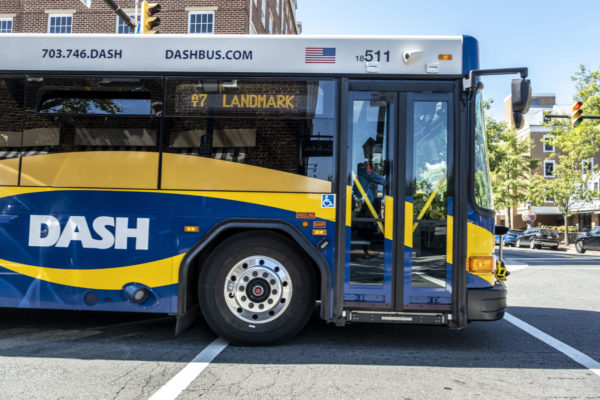
Electrification may be the future for Alexandria’s DASH bus network, but officials say diesel buses are still the present.
In a meeting with Alexandria’s Transportation Commission, DASH General Manager Josh Baker said maintaining good repair comes ahead of all other goals and cited Metro as a warning of what happens when transportation systems work the other way around.
“We’ve seen what happens on Metro when the Metro was built and not maintained,” Baker said. “For us, the top priority is good repair, followed by electrification then expansion.”
Baker said eventually the goal is to make electrification a part of DASH’s normal operations, but the funding isn’t there yet.
“I think we can get to a place where electrification is part of good repair, but at the moment, that cost differential is not funded,” Baker said.
City leadership has previously discussed the challenge of both the ambitious electric conversion of the fleet and the funding sapped away when DASH went fully fare-free. Deputy Director of Transportation Hillary Orr previously told the Transportation Commission that the city has ten buses that are reaching the end of their lifespan and, despite pledging to go electric by 2037, it was likely the replacement buses would still be gas-powered rather than electric.
“[DASH] ordered 10 diesel buses,” Baker said. “Is that a bad move? I don’t think it’s a bad move at all, we have to maintain the fleet. We want to continue to be electric, but if we don’t have the money to do it we’re not going to stop buying buses and get to the point where our service decays.”
Baker said around 14% of DASH’s buses are curently electric.
At the meeting, DASH officials said an electric bus costs $1.2 million while a diesel bus costs $600,000. Officials said the life cycle of an electric bus is less than a diesel bus, but they don’t know yet what that looks like at mid-life and end-of-life for electric buses.
A proposed extension of the King Street Trolley has reappeared in a new DASH transit plan.
The bus network’s FY 2023-2028 Transit Development Plan includes a look behind the curtain at what’s ahead for the bus network, including a plan to take the King Street Trolley down to the Eisenhower Avenue Metro station.
It’s not the first time the idea has come up. The idea was first raised back in 2020 as a longer-term goal, with hopes of implementation by 2030. Now, the Transit Development Plan says the hope is to get that extension going by FY 2026.
According to the plan:
For FY 2026, DASH proposes to extend the King Street Trolley from the King Street Metro to the Eisenhower Metro. This route extension will require up to three additional Trolley vehicles, which will be 100% electric as part of the larger effort to transition the Trolley fleet to electric buses. DASH will also seek to expand morning service hours for the Trolley and to find ways to integrate it more fully with the Old Town Circulator service. These trolley changes and any further changes to Trolley service will require additional funding, further coordination with city leadership, and approval by City Council.
The plan also includes the proposed replacement of the current hybrid trolleys with five fully electric ones, part of broader fleet electrification the bus network is struggling to find funding for.
The plan also notes that the King Street Trolley remains the most used route in the system.
Despite its post-pandemic ridership decreases, the King Street Trolley remains the most productive route with more than 20 boardings per revenue hour on weekdays and Sundays and more than 30 boardings per revenue hour on Saturdays.
https://twitter.com/DASHBus/status/1638589618407841854
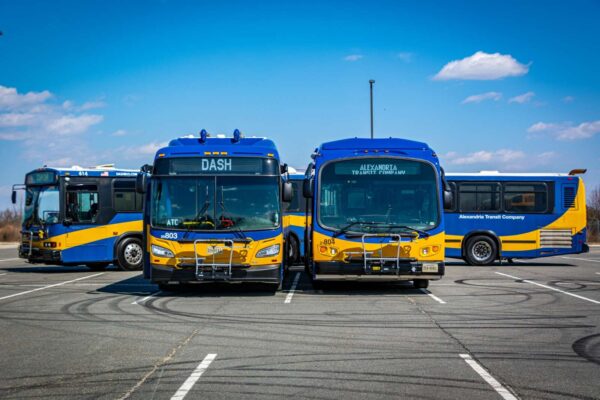
Alexandria’s DASH bus system has been going through a pair of ambitious, headline-grabbing overhauls, but city leaders are still working out how to pay for them.
In 2021, DASH went fully fare-free, meaning anyone could ride a DASH bus at any time without paying for a ticket. At the same time, the bus network has been undergoing a full-electric conversion, gradually swapping out all of the diesel buses for electric buses.
But in addition to hurdles like a lack of charging infrastructure, DASH faces the budgetary challenge of how to pay for the expensive new electric buses.
Deputy Director of Transportation Hillary Orr spoke to the Transportation Commission last week about the budget challenges facing DASH.
The city has applied for a federal grant to help convert 10 of the city’s aging buses to electric, but Orr said if the city doesn’t get that grant, the city will have to buy diesel buses rather than electric.
“If not matched, we would buy clean diesel buses because we need to replace these buses,” Orr said.
One Commissioner suggested the city could pay more for electric buses, but Orr said even using what money was set aside for DASH improvements to buy electric buses instead of diesel buses would leave the city with several buses past their expected replacement date.
“We could pay more, but then we’d have a bunch of buses that are expired because we don’t have enough with $4.8 million to replace all the clean diesels we need to replace,” Orr said. “We have 10 buses expiring… We’re doing our best to cobble together what we can and then we’ll see what we get. Whatever’s remaining, we’ll buy what we can.”
Even if Alexandria does buy more diesel buses, Orr said the city will still be on track for its goal to have a fully electric bus fleet by 2037.
“If we bought clean diesel buses, we would still be on track with our goal for 2037 having a full fleet,” Orr said. “It’s not until fiscal year 2025 that we need to start buying all-electric.”
Some on the Transportation Commission said they still hope DASH can accelerate the bus fleet electrification. According to Commissioner Jim Maslank:
I’d like to make a motion that we consider in our letter to the council that they consider additional funds as a contingency if we don’t get the money. It’s an opportunity: the whole world is going electric. 2037 is a long way away. It would be a budgetary tradeoff, but I think this committee — I personally feel we should accelerate that change, but it is going to cost the city more money. There will be tradeoffs, but that’s how I feel.
Meanwhile, the City of Alexandria will also be shouldering more of DASH’s operating costs as the bus system is weaned off the state’s Transit Ridership Incentive Program (TRIP).
“[There’s a] 18% increase in DASH funding from [fiscal year] 2023 to meet increased operating costs and decreased TRIP grant funding,” Orr said. “We get less and less each year. The TRIP grant was a grant we received when DASH went fare-free, with a little over $7 million over a four-year period. In the fourth year, DASH has to commit to being fare-free without any commitment from the state.”
“It’s like baby steps,” a Transportation Commission member said.
“Baby steps down to zero,” Orr replied less enthusiastically.
The FY 2024 budget is scheduled for adoption on May 3.
Photo via DASHbus/Facebook

Alexandria is hoping a federal grant could help push Alexandria’s DASH bus network a little closer to full electrification.
A memo from Deputy Director of Transportation Hillary Orr to the Transportation Commission said the city is hoping federal funding can help cover a sizable budget gap looming for electric bus replacement plans.
The DASH bus network has been crawling toward electrification for years despite challenges, from difficulties with hilly terrain to a lack of charging stations. The city’s goal is a fully electric fleet by 2037.
Currently, DASH has 14 electric buses in circulation and 87 “clean diesel” and hybrid buses. The bus network’s plans include replacing ten additional buses and five trolleys that have reached the end of their useful life — but replacing these buses and trolleys with electric alternatives is costly.
“To replace these assets with battery electric buses and trolleys will cost an estimated $19.3 million,” Orr wrote in the memo. “The City currently has budgeted $4,798,900 for the replacement of these buses, leaving a gap of $14.5 million.”
Beyond just the electric bus costs, Orr wrote there is an additional smaller budget gap for new clean diesel buses.
“Additionally, the City was previously awarded $4.4 million in Smart Scale funds for six clean diesel buses,” Orr wrote. “To upgrade these buses to battery electric would cost an additional $3.1 million.”
Orr wrote that DASH and City staff are submitting multiple applications to the Federal Transit Administration’s (FTA) Low or No Emission Grant Program:
The following projects could be submitted within these applications.
- Trolley Replacement (up to $6.8 million): Retire and replace five (5) trolleys with electric trolleys.
- Bus Replacement (up to $12.5 million): Retire and replace ten (10) buses with electric buses.
- Smart Scale Expansion Buses (up to $7.5 million): Upgrade six (6) Smart Scale clean diesel buses to electric buses.
- Electric upgrades at DASH Facility (up to $9 million): Build new electrical service, including on-site equipment and infrastructure to support charging need of fleet wide conversion to battery electric buses.
- Workforce Development (up to $1.6 million): Required 5% of federal request.
In total, Orr wrote that the city is seeking $38 million in grant funding.
“While it is unlikely the full grant request will be awarded, staff determined the best path forward is to propose all needs in a scalable manner by which the FTA can assess and award funds as available,” Orr wrote.
The grants are headed to the Transportation Commission for review at a meeting on Wednesday, March 15.
Photo via DASHbus/Facebook
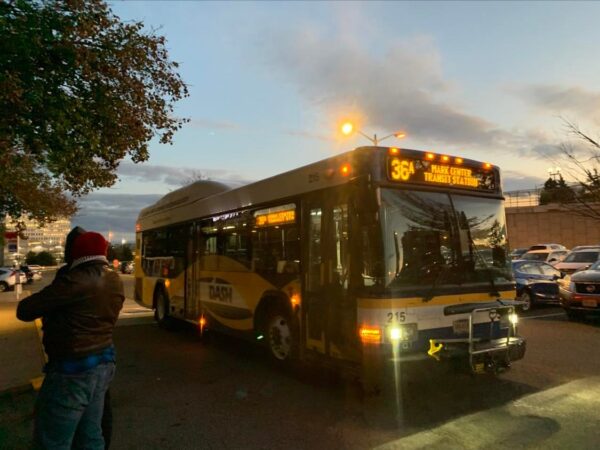
Nearly half of Alexandria’s bus stops do not meet federal accessibility standards.
It’s been a good couple years for Alexandria bus service DASH, but a new report presented to the City Council at a meeting this week by Chairman David Kaplan highlighted areas where there’s still room to improve.
“Much work needs to be done,” said Kaplan. “As good as the investments are that we’ve made in additional transit services, there are challenges when it comes to access to transit stops. The wait at the stop or the boarding process matters a lot when we have an older adult or a person with disabilities considering whether they can make a trip safely and comfortably on transit.”
Kaplan said that 42% of bus stops in Alexandria do not meet the standards laid out in the Americans with Disabilities Act (ADA). Many of those are due to non-compliant boarding areas.
Additionally:
- 18% of stops are in locations where parked cars are permitted to block the boarding area
- 22% of stops do not have a shelter
- 46% do not have a bench
Kaplan said only around 7% are built to what is considered best practices.
Beyond accessibility, City Council member Canek Aguirre said DASH and the city could be doing more to improve safety at bus stops.
“We [should] do audits at night as well to take a look at lighting,” Aguirre said. “We’ve definitely had some issues. I rode the bus with an individual working at The Fresh Market in the Bradlee Shopping Center. We got off at the same stop and it was pitch black. There was some greenery hanging over and blocking the lighting. Especially when it’s wintertime and it gets darker, lighting is another crucial piece when we talk about bus stops and shelter.”
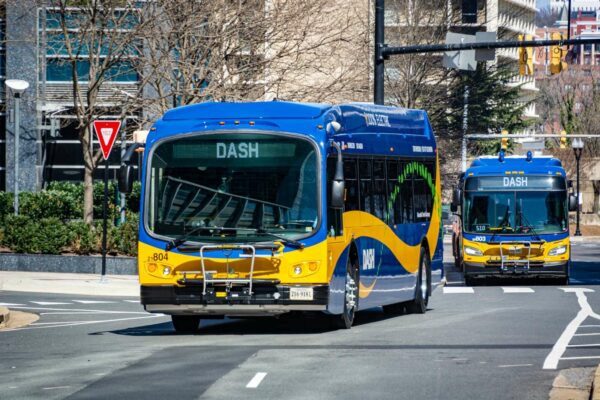
Recent data showed the DASH bus routes to the Pentagon are some of the most widely used in the system, and those lines could see delays this week due to a lane closure.
Alexandria’s DASH bus system put out a service alert that a lane closure could cause 15-20 minute delays this week for lines 35, 103, and 104.
- Line 35 runs from the Van Dorn Metro station to the Pentagon Metro station
- Line 103 runs from the Braddock Metro station to the Pentagon Metro station via Glebe Road
- Line 104 also runs from the Braddock Metro station to the Pentagon Metro station, but via Cameron Mills Drive and Parkfairfax
DASH said the delay will likely impact service on the lines on Wednesday (Jan. 4) and Thursday (Jan. 5).
https://twitter.com/DASHBus/status/1610023880541839368
Photo via DASH/Facebook
The theme of this week’s stories has been transit.
Lots of transit news around Alexandria this week, from Potomac Yard getting a new opening date to a new dashboard that allows for an easy tracking of Alexandria’s transportation statistics.
A report also showed that DASH is going strong with a new route overhaul and a fare-free program.
It was a (mostly) a positive week for transportation news.
- Man arrested after allegedly crashing into multiple cars on N. Quaker Lane
- APD: 16-year-old beaten and robbed by group on Kenmore Avenue in the West End
- All-affordable development opening in Huntington next month
- APD: Robbers steal rental car key from driver on N. Henry Street
- Four people displaced after house fire in Arlandria
- Alexandria is pushing for an independent health department
- New report shows behind-the-scenes look at successes and challenges of free bus overhaul
- Potential impact on Alexandria shuttle programs creates setback for transportation funding overhaul
- Alexandria School Board considering staggered terms, fewer members and eliminating districts
- Pedestrian struck by vehicle on N. Henry Street in Old Town


